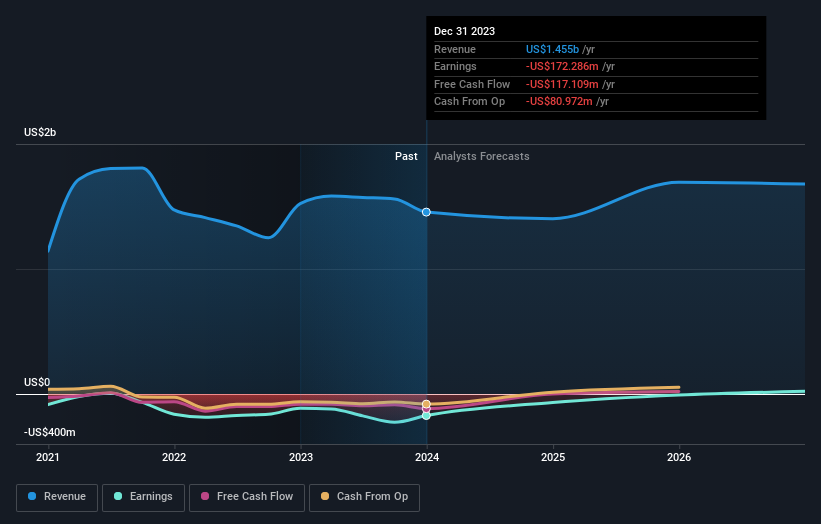TPI Composites, Inc. (NASDAQ:TPIC) Consensus Forecasts Have Become A Little Darker Since Its Latest Report

As you might know, TPI Composites, Inc. (NASDAQ:TPIC) recently reported its yearly numbers. Revenues of US$1.5b came in a modest 2.8% below forecasts. Statutory losses were a relative bright spot though, with a per-share loss of US$4.16 coming in a substantial 21% smaller than what the analysts had expected. The analysts typically update their forecasts at each earnings report, and we can judge from their estimates whether their view of the company has changed or if there are any new concerns to be aware of. So we collected the latest post-earnings statutory consensus estimates to see what could be in store for next year.
View our latest analysis for TPI Composites

Taking into account the latest results, the 13 analysts covering TPI Composites provided consensus estimates of US$1.40b revenue in 2024, which would reflect a noticeable 3.6% decline over the past 12 months. Losses are predicted to fall substantially, shrinking 60% to US$1.48. Before this earnings announcement, the analysts had been modelling revenues of US$1.49b and losses of US$1.20 per share in 2024. While this year's revenue estimates dropped there was also a sizeable expansion in loss per share expectations, suggesting the consensus has a bit of a mixed view on the stock.
The average price target was broadly unchanged at US$4.59, perhaps implicitly signalling that the weaker earnings outlook is not expected to have a long-term impact on the valuation. Fixating on a single price target can be unwise though, since the consensus target is effectively the average of analyst price targets. As a result, some investors like to look at the range of estimates to see if there are any diverging opinions on the company's valuation. There are some variant perceptions on TPI Composites, with the most bullish analyst valuing it at US$8.00 and the most bearish at US$2.50 per share. So we wouldn't be assigning too much credibility to analyst price targets in this case, because there are clearly some widely different views on what kind of performance this business can generate. As a result it might not be a great idea to make decisions based on the consensus price target, which is after all just an average of this wide range of estimates.
Of course, another way to look at these forecasts is to place them into context against the industry itself. These estimates imply that revenue is expected to slow, with a forecast annualised decline of 3.6% by the end of 2024. This indicates a significant reduction from annual growth of 4.5% over the last five years. By contrast, our data suggests that other companies (with analyst coverage) in the same industry are forecast to see their revenue grow 7.7% annually for the foreseeable future. It's pretty clear that TPI Composites' revenues are expected to perform substantially worse than the wider industry.
The Bottom Line
The most important thing to note is the forecast of increased losses next year, suggesting all may not be well at TPI Composites. Unfortunately, they also downgraded their revenue estimates, and our data indicates underperformance compared to the wider industry. Even so, earnings per share are more important to the intrinsic value of the business. The consensus price target held steady at US$4.59, with the latest estimates not enough to have an impact on their price targets.
Keeping that in mind, we still think that the longer term trajectory of the business is much more important for investors to consider. We have forecasts for TPI Composites going out to 2026, and you can see them free on our platform here.
We don't want to rain on the parade too much, but we did also find 3 warning signs for TPI Composites (2 are a bit concerning!) that you need to be mindful of.
Valuation is complex, but we're here to simplify it.
Discover if TPI Composites might be undervalued or overvalued with our detailed analysis, featuring fair value estimates, potential risks, dividends, insider trades, and its financial condition.
Access Free AnalysisHave feedback on this article? Concerned about the content? Get in touch with us directly. Alternatively, email editorial-team (at) simplywallst.com.
This article by Simply Wall St is general in nature. We provide commentary based on historical data and analyst forecasts only using an unbiased methodology and our articles are not intended to be financial advice. It does not constitute a recommendation to buy or sell any stock, and does not take account of your objectives, or your financial situation. We aim to bring you long-term focused analysis driven by fundamental data. Note that our analysis may not factor in the latest price-sensitive company announcements or qualitative material. Simply Wall St has no position in any stocks mentioned.
This article has been translated from its original English version, which you can find here.
